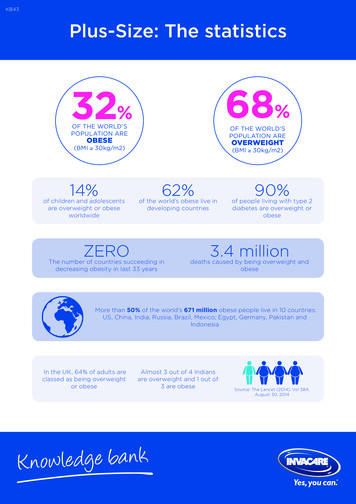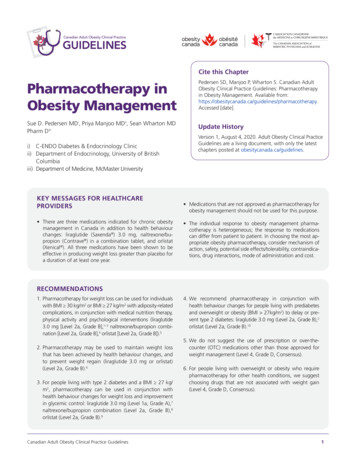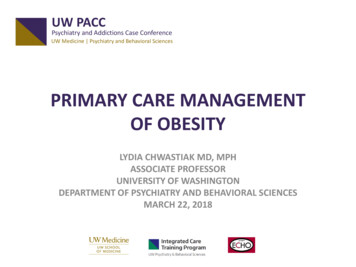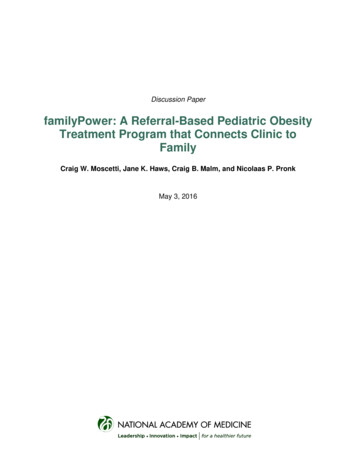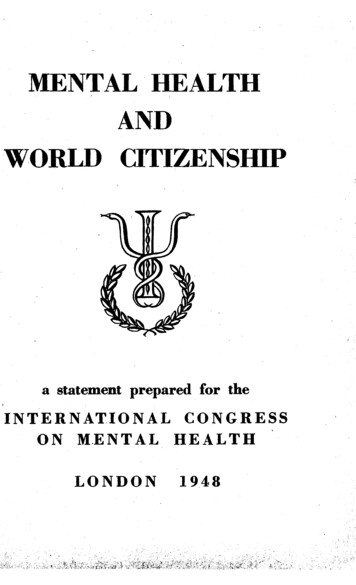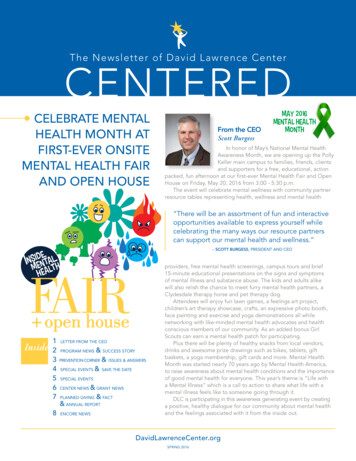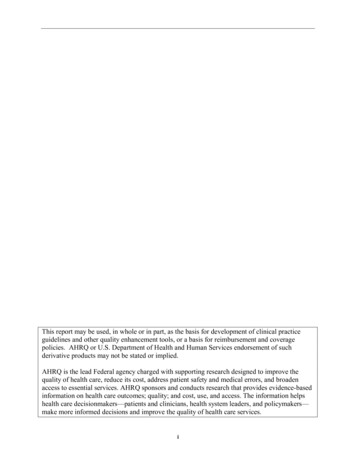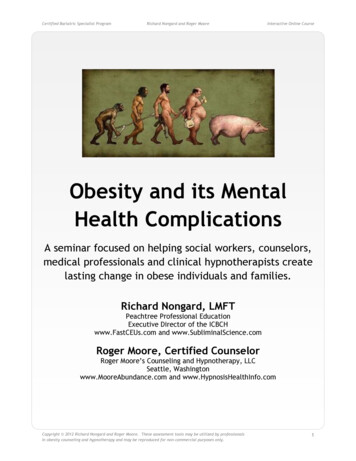
Transcription
Certified Bariatric Specialist ProgramRichard Nongard and Roger MooreInteractive Online CourseObesity and its MentalHealth ComplicationsA seminar focused on helping social workers, counselors,medical professionals and clinical hypnotherapists createlasting change in obese individuals and families.Richard Nongard, LMFTPeachtree Professional EducationExecutive Director of the ICBCHwww.FastCEUs.com and www.SubliminalScience.comRoger Moore, Certified CounselorRoger Moore’s Counseling and Hypnotherapy, LLCSeattle, Washingtonwww.MooreAbundance.com and www.HypnosisHealthInfo.comCopyright 2012 Richard Nongard and Roger Moore. These assessment tools may be utilized by professionalsin obesity counseling and hypnotherapy and may be reproduced for non-commercial purposes only.1
Certified Bariatric Specialist ProgramRichard Nongard and Roger MooreInteractive Online CourseINTRODUCTIONRichard Nongard and Roger Moore are both familytherapists and experienced experts in therapeutic weightmanagement. Both have academic, vocational andpersonal experience in helping obese individuals andfamilies. Roger is the author of “Becoming Slender forLife” and Richard is the creator of the SuccessFit Program. Together they have almost half a century ofexperience in treating eating disorders, clinicalhypnotherapy, counseling and helping clients lose weightand keep it off.Importance of the topic:Copyright 2012 Richard Nongard and Roger Moore. These assessment tools may be utilized by professionalsin obesity counseling and hypnotherapy and may be reproduced for non-commercial purposes only.2
Certified Bariatric Specialist ProgramRichard Nongard and Roger MooreInteractive Online CourseObesity is directly related to mental health:Obese clients experience greater disease and the social, family and financial complications of illness.Obesity is directly linked to suicide risk.Obese clients experience greater levels of major depression.Obesity is rarely addressed as a mental health issue. In fact, the American Journal of Psychiatrystated: “Although most mental health practitioners commonly treat obese individuals, there exists noconsensus on whether or how to address obesity in the patient’s overall treatment plan.”Family systems play a huge role in childhood obesity, and the therapist has a key opportunity to impactthe family system through effective intervention.Course Objectives:At the conclusion of this course the professional will be able to:1. Understand a model for obesity treatment that involves all elements of a bio-psycho-socialspiritual model2. Equip clients with long-term weight loss solutions3. Educate clients in the elements of eating habits and patterns proven to be most effective.4. Verbalize an understanding of core concepts related to high nutrient density food consumptionand helping client to increase daily activity5. Complete assessment of client condition related to developing a treatment plan for bothobesity and it’s mental health complications6. Reverse the cycle of addiction to obesegens, common food additives, sugars and refined food7. Create interventions drawing from multiple therapeutic approaches to create lasting changethat decreases health risk, increases emotional satisfaction and promotes mental health8. Utilize a model of intervention drawing from evidenced-based treatment protocols9. Breakthrough common blocks to success , including resistance and denial, relapse risk factorsPhilosophy of this course:This course is designed to equip the professional with the educational and experiential tools to helpindividuals and families decrease obesity, minimize risk and increase emotional health. It will begrounded in the only formula proven to have consistent evidenced based results:Increasing long-term nutrient dense food consumption while increasing daily activity results inoutcomes consistent with weight loss, increased physical and mental health and decreased risk fordisease.Copyright 2012 Richard Nongard and Roger Moore. These assessment tools may be utilized by professionalsin obesity counseling and hypnotherapy and may be reproduced for non-commercial purposes only.3
Certified Bariatric Specialist ProgramRichard Nongard and Roger MooreInteractive Online CourseTo accomplish this we will teach you interventions that:1.2.3.4.5.6.Help clients change food preferencesHelp clients increase motivation and knowledge of how to increase daily activityAlter life-long unhealthy subconscious learningsAssist client in developing realistic perceptionsAssist client in developing situational supportsAssist client in drawing from already existing strengths and resourcesWe will draw from many therapeutic modalities, often combining them. They will include, but are notlimited to:1.2.3.4.5.6.Cognitive-Behavioral PsychologyMindfulness Based Eating StrategiesApplied Clinical HypnotherapyAddiction Intervention ModelsPersonal Fitness TrainingBehavioral PsychologyWhat this course will not teach you:1.2.3.4.Application of fads within the dieting or therapy communityThe use of supplements that replace consumption of nutrient dense foodsQuick-fixes and “magical” treatmentsThat you can eat anything and lose weight; or that you can lose weight without increasing dailyactivity5. That long term change is possible without client cooperation6. That you need to buy something to be successful with weight loss clientsWhat needs to change in obesity counseling and hypnotherapy? Creation of new habits and patterns.Change of food preferencesDevelopment of food preparation skillsDevelopment of knowledge in food choices andDevelopment of activity & exercise options and knowledgeSelf-acceptanceMotivationA Basic1.2.3.4.Model of Subconscious Psychology and Applied Clinical HypnosisThe subconscious mind holds onto our lifelong learnings and experiencesMany of these are unhealthyHypnosis is one way to help client unlearn or relearn associations and reframe experiencesMindfulness and self-hypnosis teach skills that can be utilized by those with eating disorders, selfdestructive behaviors, experiencing physical withdrawal symptoms, anxiety and depression5. The basic skills of mindfulness and self-hypnosis include: Directed attention, state change, physicalawareness and creative visualizationDemonstration of Basic Induction and Suggestion Strategy using Skill-Building HypnosisCopyright 2012 Richard Nongard and Roger Moore. These assessment tools may be utilized by professionalsin obesity counseling and hypnotherapy and may be reproduced for non-commercial purposes only.4
Certified Bariatric Specialist ProgramRichard Nongard and Roger MooreInteractive Online CourseFOOD AWARENESS AND EDUCATIONCopyright 2012 Richard Nongard and Roger Moore. These assessment tools may be utilized by professionalsin obesity counseling and hypnotherapy and may be reproduced for non-commercial purposes only.5
Certified Bariatric Specialist ProgramRichard Nongard and Roger MooreInteractive Online CourseBasic Nutrition InformationThe four biggest problems with the Standard American Diet (S.A.D.) are:1.2.3.4.Lack of food/nutritional knowledgePrevalence of unhealthy foods in our food supplyMisinformation or misleading information about nutrition and foodAt a conspiratorial level – the profit and politics of commercial agriculture and food productionWater:Fats:Polyunsaturated FatsMonounsaturated FatsSaturated FatTrans-FatProtein:Complete ProteinIncomplete ProteinCarbohydrate:Complex CarbohydratesDietary Fiber (Soluble vs. Insoluble)Simple CarbohydratesCholesterol:Summary:A plant-based diet,rich in nutritionaldensity while limitingfood choices that areeither artificial,processed orsecondary suppliersof nutrition (meatand dairy) is bestaccording toresearch.This does not mean:Veganism orvegetarianism is theonly choice; it issimply a betterchoice more oftenVitamins and Minerals:Calories:Sugars:Additives:Copyright 2012 Richard Nongard and Roger Moore. These assessment tools may be utilized by professionalsin obesity counseling and hypnotherapy and may be reproduced for non-commercial purposes only.6
Certified Bariatric Specialist ProgramRichard Nongard and Roger MooreTotal Calories Per DayInteractive Online CourseFood Labeling Reference TablesWomen1800 – 2000Men2200 – 2700Children1500 – 2000For people four years or older, eating 2,000calories per day, the DRVs are:Total Fat65 gSaturated Fatty Acids20 gProtein RequirementsCholesterol300 mgWorld Health Organization 5% of total caloriesshould be from protein (Oatmeal: 10 – 15%protein)Sodium2300 mgPotassium4700 mgTotal Carbohydrate300 gFiber25 gProtein50 gHigher-Protein Plant Foods(Serving size: 1 cup, cooked)caloriesprotein(g)fat(g)Baked beans (vegetarian)23512.21.1Black beans22715.20.9Chickpeas28511.92.7Kidney beans22515.40.9Lentils23117.90.7Lima beans21714.70.7Navy beans 25915.81.0Peas1348.60.4Pinto beans23514.00.9Split peas23116.40.8LegumesCopyright 2012 Richard Nongard and Roger Moore. These assessment tools may be utilized by professionalsin obesity counseling and hypnotherapy and may be reproduced for non-commercial purposes only.7
Certified Bariatric Specialist ProgramRichard Nongard and Roger MooreInteractive Online CourseHOW TO READ A FOOD LABELLabel terms that have no meaning or are misleading:1.2.3.4.5.6.7.All naturalLow-FatNo Trans FatExtra lightNo added Plus (think toaster pastries)A good source of fiber8.9.10.11.12.13.Strengthens your immune systemMade with REAL fruit, cheese, etc.Made with whole grainsMulti-grainLightly sweetenedLow sugarCopyright 2012 Richard Nongard and Roger Moore. These assessment tools may be utilized by professionalsin obesity counseling and hypnotherapy and may be reproduced for non-commercial purposes only.8
Certified Bariatric Specialist ProgramRichard Nongard and Roger MooreInteractive Online CourseCLIENT ASSESSMENTCopyright 2012 Richard Nongard and Roger Moore. These assessment tools may be utilized by professionalsin obesity counseling and hypnotherapy and may be reproduced for non-commercial purposes only.9
Certified Bariatric Specialist ProgramRichard Nongard and Roger MooreInteractive Online CourseMENTAL & EMOTIONAL ROADBLOCKSDr. Jeff SklareEmail: Drsklare@innerdiet.comWebsite: http://www.innerdiet.com/CommitmentDiscomfortInner ControlPerfectionismSecondary GainStressCopyright 2012 Richard Nongard and Roger Moore. These assessment tools may be utilized by professionalsin obesity counseling and hypnotherapy and may be reproduced for non-commercial purposes only.10
Certified Bariatric Specialist ProgramRichard Nongard and Roger MooreInteractive Online CourseNONGARD-MOORE RELAPSE RISK ASSESSMENT“Obesity is not just a physical problem. It’s an all-inclusive disorder that has been linked to fifty-five differentmedical complications, including many affecting the brain.” Lee M. Kaplan, MDWhat obstacles may impede your ability to stay healthy?Which of the following weight loss obstacles are present in your life? Recognizing these indicators willhelp build strategies for successfully avoiding or confronting the challenges ahead.Checkmark or write YES next to any of the following statements that may apply to you: 1. I drink alcoholic beverages more than 3 times per week. 2. I live with an obese person. 3. Snacks are freely available in my work environment. 4. I eat prepackaged deserts or snacks at least once a day. 5. This is my first attempt to control my weight and diet. 6. I am facing stressful life events beyond my control at this time. 7. I would rather risk the damage from obesity than have to make hard changes. 8. I like eating what I want to and do not want to change my diet. 9. I have tried to lose weight several times and fear I won't succeed this time. 10. People won't like me if I don't eat with them, and eat what they eat. 11. I will be dull and boring if I wasn’t a “foodie”. 12. If I can just make a couple changes and not too many I will be happy. 13. I eat when I am stressed. 14. I don’t believe I can ever be successful. 15. Dieting means never being able to eat the things you like. 16. I eat more than 10 meals a month in restaurants or fast-food places. 17. I do not intend to change my eating habits forever, just until I reach my goal. 18. Dieting makes me angry. 19. I sneak (secretly) eat. 20. I violate my own values with food. 21. Once I cheat on a diet, the diet is really over for me. 22. There are advantages to being overweight. 23. I consider myself an inactive person. 24. Even the idea of exercise makes me uncomfortable. 25. I come from a family that spends time mostly doing indoor activity.Copyright 2012 Richard Nongard and Roger Moore. These assessment tools may be utilized by professionalsin obesity counseling and hypnotherapy and may be reproduced for non-commercial purposes only.11
Certified Bariatric Specialist ProgramRichard Nongard and Roger MooreInteractive Online CourseTHE CYCLE OF FOOD ADDICTION“When you are addicted to drugs, you put the tiger in the cage to recover. When you are addicted to food, youput the tiger in the cage, but take it out three times a day for a walk.” anonymousAddictive Qualities of Food1. Sugar stimulates the brain's reward centers through theneurotransmitter dopamine, exactly like other addictivedrugs.2. Brain imagining (PET scans) shows that high-sugar and highfat foods work just like heroin, opium, or morphine in thebrain.3. Brain imaging (PET scans) shows that obese people and drugaddicts have lower numbers of dopamine receptors, makingthem more likely to crave things that boost dopamine.4. Foods high in fat and sweets stimulate the release of thebody's own opioids (chemicals like morphine) in the brain.5. Drugs we use to block the brain's receptors for heroin andmorphine (naltrexone) also reduce the consumption andpreference for sweet, high-fat foods in both normal weightand obese binge eaters.6. People (and rats) develop a tolerance to sugar -- they needmore and more of the substance to satisfy them -- just like they do for drugs of abuse likealcohol or heroin.7. Obese individuals continue to eat large amounts of unhealthy foods despite severe social andpersonal negative consequences, just like addicts or alcoholics.8. Animals and humans experience "withdrawal" when suddenly cut off from sugar, just likeaddicts detoxifying from drugs.9. Just like drugs, after an initial period of "enjoyment" of the food, the user no longer consumesthem to get high but to feel normal.Roadblocks to Success CommitmentDiscomfortInner ControlPerfectionismSecondary GainStress EatingWhy Clients are difficult (Resistance & Denial)1.2.3.4.5.6.7.8.9.10.11.FearLack of optionsCultural and value differencesOver-reactionImpaired by chemicals or catastrophic mental illnessEmotional paralysisLimited approachesNeeds are metConflict gains attentionIgnoranceThe familiarity trapCopyright 2012 Richard Nongard and Roger Moore. These assessment tools may be utilized by professionalsin obesity counseling and hypnotherapy and may be reproduced for non-commercial purposes only.12
Certified Bariatric Specialist ProgramRichard Nongard and Roger MooreInteractive Online CourseWHAT IS MINDFULNESS?Mindfulness is the art of paying attention with non-judgmental awareness to this moment. The resultof mindfulness training stress control:1.2.3.4.5.Letting go of past hurts, and a focus on the pastDecreased anxiety about the futureAwareness of the present and altering automatic behaviorsThe ability to self-regulate feelings and sensationsResearch shows it is a tool for releasing depression, anxiety and angerRAISIN MEDITATIONBring your attention to the raisin observing it carefully as if you had never seen one before. Touchthe raisin with a finger. Is it rough or smooth? Thick or thin? Hard or soft? Feel its texturebetween your fingers Feel the weight of it and notice its colors. Be aware of any thoughts youmight be having about the raisin. Note any thoughts or feelings of liking or disliking raisins. Notice thecolor the topography and the scent of a raisin. Look into the valleys and peaks thehighlights and dark crevasses.Lift the raisin under your nose and smell. What does it remind you off?Close your eyes and bring it to your lips, being aware of the arm moving the hand to position itcorrectly and of your mouth salivating as the mind and body anticipate eating. Feel the emptinessin your mouth.Take the raisin into your mouth and just allow it to sit there for a moment. Do not chew it. Slowlymove it around with your tongue. As the raisin lays in your mouth, notice if the raisin is warm orcold notice the texture notice the rough edges and notice the smooth surfaces the flavor notice the subtleties of the flavor.Bite down once into the raisin and hold it between your teeth notice the sweetness notice yourthoughts your emotions notice your breathing. As you separate your teeth now what do younotice about the texture? Notice how the texture changes as you chew Are you aware of howwarm the raisin has become? Has it become juicier?Notice any anxiety or stress you may feel by not swallowing What is that about?Slowly finish chewing and when the raisin is all but dissolved, go ahead and swallow.Copyright 2012 Richard Nongard and Roger Moore. These assessment tools may be utilized by professionalsin obesity counseling and hypnotherapy and may be reproduced for non-commercial purposes only.13
Certified Bariatric Specialist ProgramRichard Nongard and Roger MooreInteractive Online CourseHUNGER MEDITATIONThe purpose of a mindfulness meditation on hunger, is to become accepting of hunger as just a normalpart of life, rather than something that must be acted on immediately to end a “negative” sensation.Hunger is neither positive nor negative, it is not something that must be acted upon in any particularway. Hunger lets us know our body is working as it should, and simply is an experience of life, one thatcan be had without judgment or attaching meaning. In the past it was a cue to eat, and in manycases, a cue to eat whatever possible just to make the feeling go away. Now, it is simply seen as it is:Hunger.As you breath in and out, focusing on the breath, neither try to speed up or slow down the breath, justnotice it. Bring your attention to this moment, scanning the body for any obvious tensions, and letthem melt away, relaxing the muscles of the body. Return to the breath, to this moment, seeingyourself just as you are at this moment. Now bring your attention to the core, to the place in yourbody where hunger is created and experienced. Notice the way it feels, where it begins and how far itradiates up the chest or below the stomach. And notice, your ability to notice this feeling, withoutjudgment, and without action, simply letting the body be as the body is at this moment. Fullyaccepting your present state, seeing it as neither good nor bad, but as just a sensation.Return your attention now to the breath. Breathing in and out. Seeing the breath in this moment.Breathing in. Breathing out.SELF-HYPNOSISTips for Creating Self-Suggestions1. Keep suggestions short and concise.2. Use only positive words. Do not use ‘no,’ ‘not,’ ‘don’t,’ etc. (Your subconscious mind may notgrasp a negative qualifier and you might get the opposite result.)3. Keep vocabulary simple. A 6-year-old child should understand it.4. Practice using ‘I’ statements, ‘You’ statements and ‘He/She’ statements and see what worksbest for you. For example: I feel my body becoming healthier every day; you are enjoyingeating foods that promote weight release; she keeps her promises to herself about healthyeating.5. Use only two or three suggestions per session when using the light switch technique.6. Use only present tense words. Never use ‘will,’ ‘want to,’ ‘going to’ or ‘like to’.7. Use action words such as ‘enjoy,’ ‘love,’ or ‘desire.’8. Place yourself in a SAFE and COMFORTABLE position.9. GIVE YOURSELF A TIME LIMIT (one minute).10. Raise and lower your index finger. When your finger touches whatever it is resting on, closeyour eyes and drop into a deep state of hypnosis. TURN YOUR LIGHT SWITCH OFF.11. While you are in hypnosis DO NOT THINK ABOUT THE TIME. Your subconscious mind does thatfor you.12. Emerge when you have the feeling that your time is up.Copyright 2012 Richard Nongard and Roger Moore. These assessment tools may be utilized by professionalsin obesity counseling and hypnotherapy and may be reproduced for non-commercial purposes only.14
Certified Bariatric Specialist ProgramRichard Nongard and Roger MooreInteractive Online CourseLight-switch Technique1. Place yourself in a SAFE and COMFORTABLE position.2. GIVE YOURSELF A TIME LIMIT (one minute).3. Raise and lower your index finger. When your finger touches whatever it is resting on, closeyour eyes and drop into a deep state of hypnosis. TURN YOUR LIGHT SWITCH OFF.4. While you are in hypnosis DO NOT THINK ABOUT THE TIME. Your subconscious mind does thatfor you.5. Emerge when you have the feeling that your time is up.Body Scan TechniqueSelf-Talk and DepressionDevalue SituationDevalue SelfDevalue FutureCopyright 2012 Richard Nongard and Roger Moore. These assessment tools may be utilized by professionalsin obesity counseling and hypnotherapy and may be reproduced for non-commercial purposes only.15
Certified Bariatric Specialist ProgramRichard Nongard and Roger MooreInteractive Online CourseMedical complications and weight loss and how to reverse diseaseCounseling difficult clients: 11 Solutions for motivating clients and overcoming resistance1.2.3.4.5.6.7.8.9.10.11.Eliminate power strugglesFeed clients therapeutic big-macsTeaching IS counselingStop believing in deniala. Smartb. Ignorancec. Easy wayUse strengths to compensate for weaknessesMotivation is the key to changea. Towards vs. away motivationb. How to remove barriers to motivationi. Adviceii. Remove Barriersiii. Give Clients Choicesiv. Decrease Attractionv. Set Goalsvi. Manifest a Helping Attitudevii. Provide Feedbackviii. Draw on External ContingenciesGive your clients a million dollars!Paradoxical IntentionBring in others and use external resourcesHealthy ModelingLet the Train Wreck HappenCOGNITIVE-BEHAVIORAL THERAPY WITH OBESE CLIENTS1. Recognize cognitive error2. Remove cognitive errors3. Replace cognitive errorsEducationCounteringChallengingPerceptual shiftConditioningLogical AnalysisCopyright 2012 Richard Nongard and Roger Moore. These assessment tools may be utilized by professionalsin obesity counseling and hypnotherapy and may be reproduced for non-commercial purposes only.16
Certified Bariatric Specialist ProgramRichard Nongard and Roger MooreInteractive Online CourseWHY DO DIETS FAIL?“If you eat less of a bad thing You simply die slower.” - Richard Nongard There is a short term mindsetDieting makes you hungryDieting sees fat loss as a function of food intake only, not exercise and activityDiets make you tiredDiets cannibalize the musclesDiets can be expensiveDiets are temporaryDiets lower metabolismRestriction/Reward creates a yo-yo effectBariatric SurgeryAccording to the Mayo Clinic, various risks associated with gastric bypass surgery include death, bloodclot formation in the legs and pneumonia. 1-2% Mortality“Dumping” syndrome1/3 of patients develop gallstones; so the gallbladder is often removed as prevention.Hair lossFood IntoleranceG.I. ProblemsSmokers who have gastric surgery will most likely develop ulcers in the pouch.Kidney stonesCopyright 2012 Richard Nongard and Roger Moore. These assessment tools may be utilized by professionalsin obesity counseling and hypnotherapy and may be reproduced for non-commercial purposes only.17
Certified Bariatric Specialist ProgramRichard Nongard and Roger MooreInteractive Online CourseUNDERSTANDING FOOD LABELSWritten by Jeff NovickSaturday, 19 March 2005Cutting Through The Confusion. How to make sense of the food label.Here are the basics of deciphering food labels, consolidated into ten quick-referencetips.1. Never believe the claims on the front of the box.What many think are health claims are actually just marketing pitches and advertisements. Andgovernment approved claims, like “low-fat” and “light,” often don’t tell you the whole story. Theseproducts may be high in fat as well as sugar, salt, and/or calories.“Light” ice cream, for example, may still pack in 4 to 5 grams of fat per serving. And “light” and“regular” varieties of ice cream may not differ much calorically.Never evaluate a product based on one item, such as its fat, cholesterol, sugar, carbohydrate, or saltcontent. Attempting to cash in on the latest diet or nutrition craze, many companies promote theirproducts based on a single item despite other unhealthy aspects. (Remember “fat-free” foods thatwere full of sugar and calories?) To be truly healthy, a product must pass severalcriteria.2. Always read the Nutrition Facts label and the ingredient list.They contain information that can really help you determine how healthy a food is.Crackers, for example, may advertise on the front of the box that they’re “trans fatfree,” but in the ingredient list you may find fats, like palm oil and coconut oil, thatare just as artery-clogging as the trans fats they replaced.(Tips 3 through 7 show you how to read the Nutrition Facts label.)3. Check the serving size.Though the government standardized most serving sizes years ago, many products still postunrealistically small sizes. A serving of oil spray, for instance, is .25 grams. That’s about 120th of anounce — far less than most people could, or would, spray on a pan with even just one squirt.4. Check the amount of servings per package.Decades ago, many products were in fact single servings. A bottle of cola was one serving. One smallcandy bar was one serving. Today, many products are “super sized” and contain multiple servings. A20-ounce bottle of soda contains 2.5 servings, at 110 calories each. Now, in the real world, who’s goingto drink just one serving of that bottle? Is it any surprise that many of us are super sized ourselves?5. Check the calories per serving.Copyright 2012 Richard Nongard and Roger Moore. These assessment tools may be utilized by professionalsin obesity counseling and hypnotherapy and may be reproduced for non-commercial purposes only.18
Certified Bariatric Specialist ProgramRichard Nongard and Roger MooreInteractive Online CourseAll too many people think the “110 calories” posted on that 20-ounce bottle of cola means they’redrinking 110 calories. Hardly. You’ve got to multiply the 110 calories by the total number of servings,2.5, to realize that you’re actually downing a whopping 275 calories.Don’t get too comfortable with “0s” either. Because some manufacturers use ridiculously small servingsizes (remember that 120th of an ounce of cooking spray?) and because the FDA states thatmanufacturers can “round down” to zero, some products advertised as calorie-free or fat-free are not.If you eat multiple servings — if, say, you coat an entire skillet with oil spray — you may be tallying upquite a few calories.6. Check the calories from fat.It’s on the Nutrition Facts label. Unfortunately, it doesn’t tell you “percent ofcalories from fat,” which is how all health guidelines direct us to limit fat.You’ve got to do a little math. Divide the number of calories from fat by thetotal calories. (If the serving’s 150 calories, 50 of which are fat, your productis 33 percent calories from fat.).If division trips you up, go by grams. Use this easy rule. If a product has 2grams of fat or less per 100 calories, its fat content is within these guidelines for processed foods: thefat, per serving, is 20 percent or less of total calories. You don’t have to be a mathematician to realizethat 4 grams of fat per 100 calories is double the fat I recommend.Don’t be fooled by claims like “99 percent fat-free” soup or “2 percent fat” milk. They’re based onpercent of weight, not percent of calories. So that can of 99 percent fat-free soup may actually have77 percent of its calories from fat, or more. And 2 percent fat milk actually has about 34 percent oftotal calories from fat; 1 percent milk has about 23 percent calories from fat.7. Check the sodium.Don’t bother with the percentage of Daily Value (DV) of sodium. Don’t bother with Daily Valuepercentages, period. They’re based on government standards, which are generally not the healthiestguidelines to strive for.Instead, look at the number of milligrams of sodium the serving contains. A great rule of thumb: Limitthe sodium in milligrams to no more than the number of calories in each serving. Your daily goal: lessthan 1,500mg of sodium.(Tips 8, 9, and 10 show you how to read the ingredient list.)8. Check the types of fat.Make sure there are no saturated fats, hydrogenated fats, or tropical oils in the ingredient list,including lard, butter, coconut, cocoa butter, palm oils, shortening, margarine, chocolate, and wholeand part-skim dairy products.Polyunsaturated fats (like safflower, soybean, corn, and sesame) and monounsaturated fats (such asolive and canola) are less harmful and would be acceptable, but make sure the percentage of caloriesfrom fat are still in line — 20 percent calories from fat or less — or your waistline may start getting outof line. All oils, even “good” oils, are dense with calories.Copyright 2012 Richard Nongard and Roger Moore. These assessment tools may be utilized by professionalsin obesity counseling and hypnotherapy and may be reproduced for non-commercial purposes only.19
Certified Bariatric Specialist ProgramRichard Nongard and Roger MooreInteractive Online Course9. Check the sugar.Limit caloric sweeteners. Watch out for sugars and other caloric sweeteners that don’t say “sugar” butin fact are, such as corn syrup, rice and maple syrup, molasses, honey, malted barley, barley malt, o
www.FastCEUs.com and www.SubliminalScience.com Roger Moore, Certified Counselor Roger Moore's Counseling and Hypnotherapy, LLC Seattle, Washington www.MooreAbundance.com and www.HypnosisHealthInfo.com . Certified Bariatric Specialist Program Richard Nongard and Roger Moore Interactive Online Course
